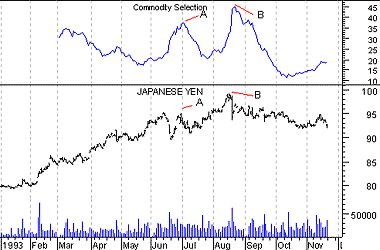
Technical Analysis from A to Z
by Steven B. Achelis
COMMODITY SELECTION INDEX
Overview
The Commodity Selection Index ("CSI") is a momentum indicator. It was developed by Welles Wilder and is presented in his book New Concepts in Technical Trading Systems.
The name of the index reflects its primary purpose. That is, to help select commodities suitable for short-term trading.
Interpretation
A high CSI rating indicates that the commodity has strong trending and volatility characteristics. The trending characteristics are brought out by the Directional Movement factor in the calculation--the volatility characteristic by the Average True Range factor.
Wilder's approach is to trade commodities with high CSI values (relative to other commodities). Because these commodities are highly volatile, they have the potential to make the "most money in the shortest period of time." High CSI values imply trending characteristics which make it easier to trade the security.
The Commodity Selection Index is designed for short-term traders who can handle the risks associated with highly volatile markets.
Example
The following chart shows the Japanese Yen and its 14-day CSI. Strong volatility and strong trends result in high CSI values at points "A" and "B."

Calculation
It is beyond the scope of this book to provide full calculation details on the Commodity Selection Index. It is calculated using the ADXR component of the Directional Movement indicator. Wilder's book New Concepts in Technical Trading Systems contains detailed information on the calculation of the CSI.
Contents
- Preface
- Acknowledgments
- Terminology
- To Learn More
- Bibliography
- About the Author
- Technical Analysis
- Price Fields
- Charts
- Support & Resistance
- Trends
- Moving Averages
- Indicators
- Market Indicators
- Line Studies
- Periodicity
- The Time Element
- Conclusion
- Absolute Breadth Index
- Accumulation/Distribution
- Accumulation Swing Index
- Advance/Decline Line
- Advance/Decline Ratio
- Advancing-Declining Issues
- Advancing, Declining, Unchanged Volume
- Andrews' Pitchfork
- Arms Index
- Average True Range
- Bollinger Bands
- Breadth Thrust
- Bull/Bear Ratio
- Candlesticks - Japanese
- CANSLIM
- Chaikin Oscillator
- Commodity Channel Index
- Commodity Selection Index
- Correlation Analysis
- Cumulative Volume Index
- Cycles
- Demand Index
- Detrended Price Oscillator
- Directional Movement
- Dow Theory
- Ease of Movement
- Efficient Market Theory
- Elliott Wave Theory
- Envelopes (Trading Bands)
- Equivolume/Candlevolume
- Fibonacci Studies
- Four Percent Model
- Fourier Transform
- Fundamental Analysis
- Gann Angles
- Herrick Payoff Index
- Interest Rates
- Kagi
- Large Block Ratio
- Linear Regression Lines
- MACD
- Mass Index
- McClellan Oscillator
- McClellan Summation Index
- Median Price
- Member Short Ratio
- Momentum
- Money Flow Index
- Moving Averages
- Negative Volume Index
- New Highs-Lows Cumulative
- New Highs-New Lows
- New Highs/Lows Ratio
- Odd Lot Balance Index
- Odd Lot Purchases/Sales
- Odd Lot Short Ratio
- On Balance Volume
- Open Interest
- Open-10 TRIN
- Option Analysis
- Overbought/Oversold
- Parabolic SAR
- Patterns
- Percent Retracement
- Performance
- Point & Figure
- Positive Volume Index
- Price and Volume Trend
- Price Oscillator
- Price Rate-of-Change
- Public Short Ratio
- Puts/Calls Ratio
- Quadrant Lines
- Relative Strength, Comparative
- Relative Strength Index
- Renko
- Speed Resistance Lines
- Spreads
- Standard Deviation
- STIX
- Stochastic Oscillator
- Swing Index
- Three Line Break
- Time Series Forcast
- Tirone Levels
- Total Short Ratio
- Trade Volume Index
- Trendlines
- TRIX
- Typical Price
- Ultimate Oscillator
- Upside/Downside Ratio
- Upside/Downside Volume
- Vertical Horizonal Filter
- Volatility, Chaikin's
- Volume
- Volume Oscillator
- Volume Rate-of-Change
- Weighted Close
- Williams' Accumulation/Distribution
- Williams' %R
- Zig Zag